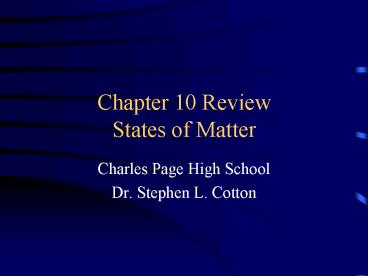Chapter 10 Review States of Matter - PowerPoint PPT Presentation
1 / 15
Title:
Chapter 10 Review States of Matter
Description:
... the kinetic theory ... The average kinetic energy of all the molecules in liquid water at ... (Temperature depends on the kinetic energy of the particles, not on ... – PowerPoint PPT presentation
Number of Views:145
Avg rating:3.0/5.0
Title: Chapter 10 Review States of Matter
1
Chapter 10 ReviewStates of Matter
- Charles Page High School
- Dr. Stephen L. Cotton
2
Chapter 10 Review - definitions
- Amorphous
- Unit cell
- Crystal
- Normal boiling point
- Barometer
3
Chapter 10 Review - definitions
- Atmospheric pressure
- Melting point
- Sublimation
- Boiling point
- Kinetic theory
4
Chapter 10 Review - definitions
- Allotrope
- Vapor pressure
- Evaporation
- Supercooled liquid
5
Chapter 10 Review
- Does steam at 200 oC or liquid water at 373 K
have the greatest average kinetic energy? - Know the kinetic theory of gases
- At what temperature does the motion of particles
theoretically cease?
(the steam)
(0 K, which is absolute zero)
6
Chapter 10 Review
- How is temperature related to average kinetic
energy? - Know the statements of the kinetic theory.
- What are standard conditions when working with
gases?
(directly proportional)
(0 oC and 101.3 kPa)
7
Chapter 10 Review
- 76.0 mm Hg _______ atm.
- What does a phase diagram gives information on?
- What would an increase in temperature do to the
vapor pressure above a liquid?
(0.1)
(temperature and pressure at which a substance is
gas, liquid, or solid)
(increase it)
8
Chapter 10 Review
- How can you boil water at 105 oC?
- The direct change of a substance from a solid to
a gas is called ___________. - Know characteristics of solids.
- The escape of gas molecules from the surface of
an uncontained liquid is
(increase the air pressure above the water)
(sublimation)
(evaporation)
9
Chapter 10 Review
- AT, ST, or NT
- Rate of evaporation and condensation are equal at
equilibrium. - Kinetic energy of all the molecules in a
collection of molecules is the same.
(AT)
(NT)
10
Chapter 10 Review
- AT, ST, or NT
- The average kinetic energy of all the molecules
in liquid water at 80 oC is the same as the
average kinetic energy of the molecules in oxygen
gas at 80 oC
(AT)
11
Chapter 10 Review
- AT, ST, or NT
- Adding heat to a liquid will increase the
temperature of the liquid. - The melting point and freezing point of a
substance are equal.
(ST)
(AT)
12
Chapter 10 Review
- Change 3.70 atm to kPa.
- Change 3.70 atm to mm Hg
- Explain why temperature of a gas does not depend
on the number of particles.
(375 kPa)
(2.81 x 103 mm Hg)
(Temperature depends on the kinetic energy of the
particles, not on the number.)
13
Chapter 10 Review
- A gas has a pressure of 610.0 mm Hg. What is the
pressure in atmospheres? - What is the pressure of the gas above, expressed
in kilopascals?
(0.803 atm)
(81.3 kPa)
14
Chapter 10 Review
- A 100 g sample of water is heated from 50 oC to
100 oC. At 100 oC, although heat is still
applied, the temperature of the water does not
rise. Explain why.
(The additional heat is being used to change the
liquid water to gas. The escaping molecules
carry off the excess energy, and the temperature
of the water will not rise until all of the water
is in the gaseous state.)
15
Chapter 10 Review
- Some types of bacteria are killed by being heated
to a temperature of 150 oC for 30 minutes.
Explain why this will kill them, but boiling
water at atmospheric pressure will not.
(When water boils at standard atmospheric
pressure, it cannot be heated above 100 oC. Only
water at pressures of more than one atmosphere
will boil at a higher temperature to kill the
bacteria.)































